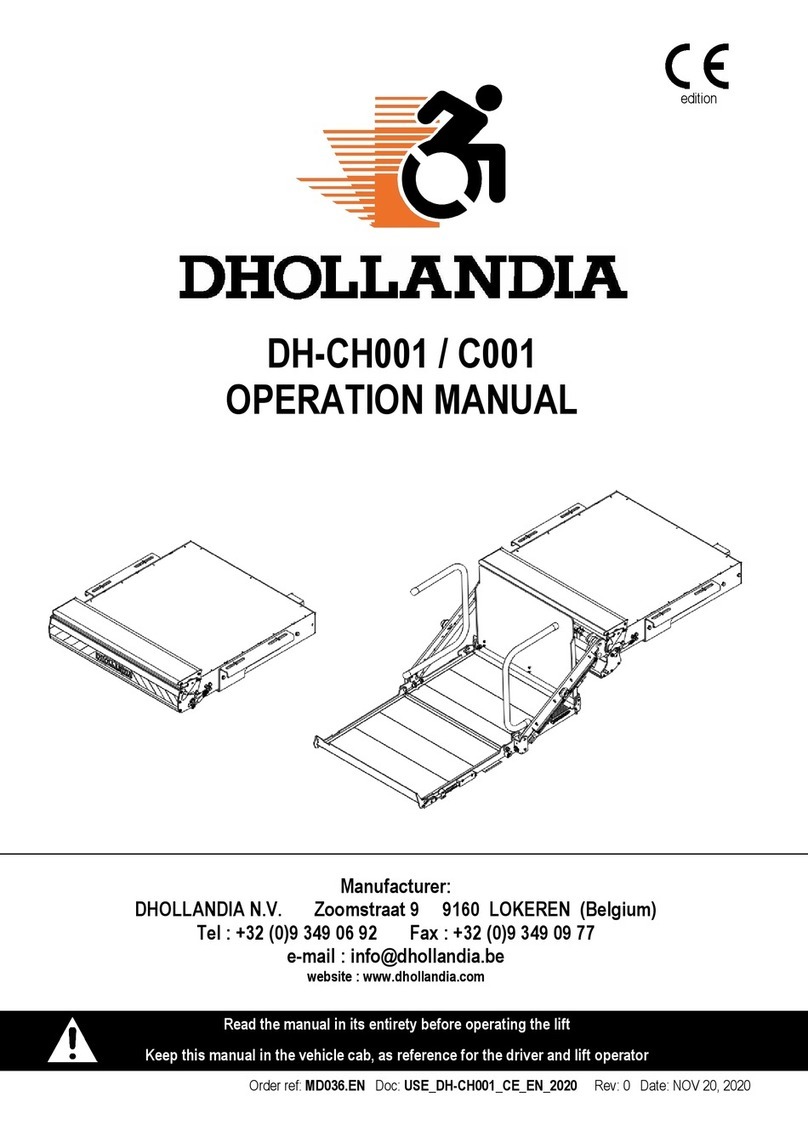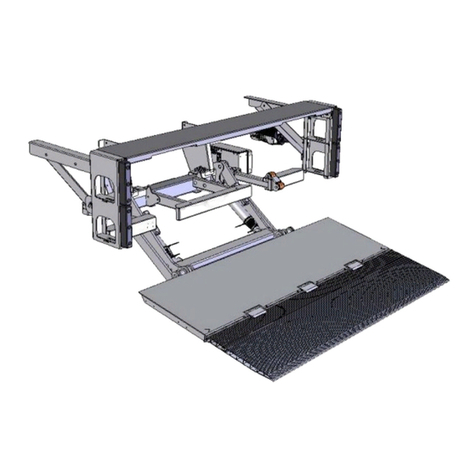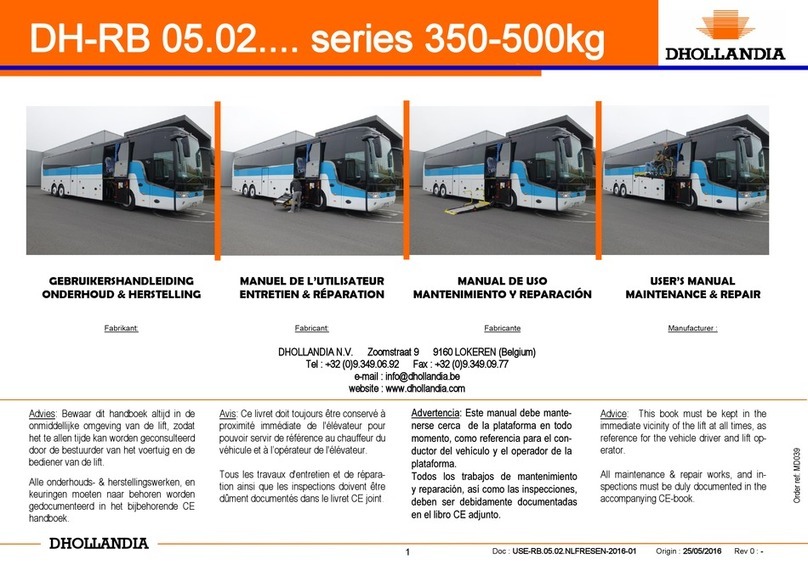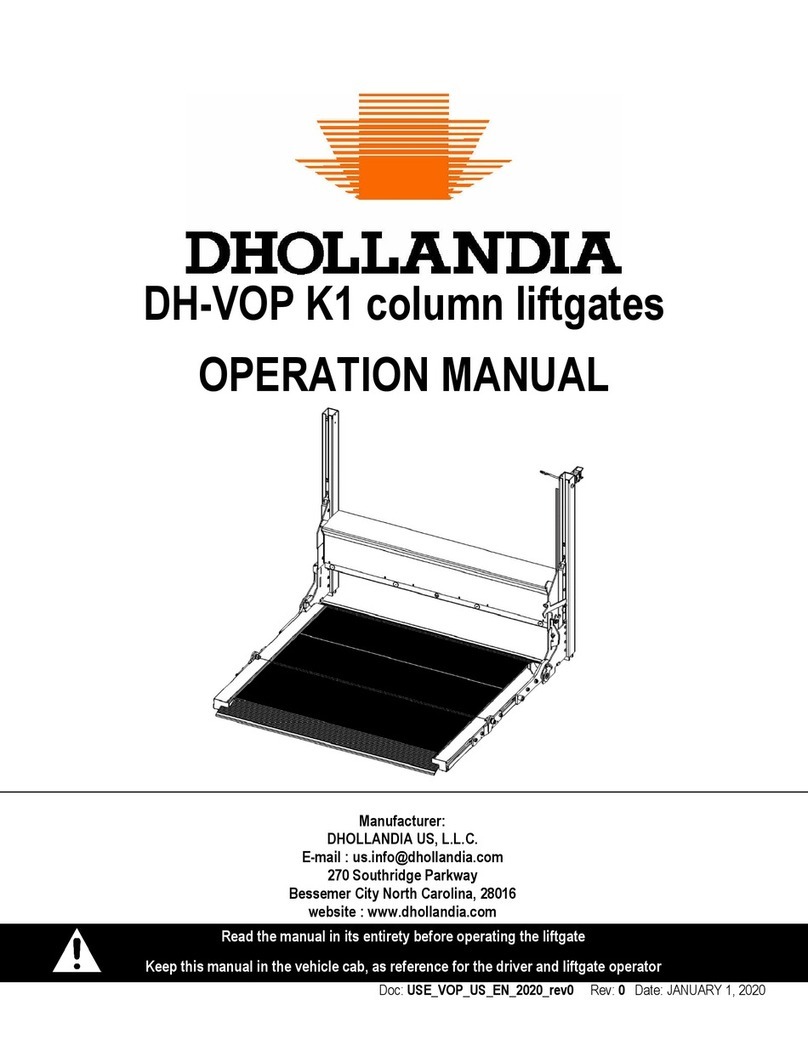Dhollandia DH-VO Series User manual

Doc: USE_VO_VB_VX_US_EN_2020_rev0 Rev: 0Date: JANUARY 1, 2020
Manufacturer:
DHOLLANDIA US, L.L.C.
270 Southridge Parkway
Bessemer City North Carolina, 28016
website : www.dhollandia.com
DH-VO, VB, VX multi-deck liftgates
OPERATION MANUAL
Read the manual in its entirety before operating the liftgate
Keep this manual in the vehicle cab, as reference for the driver and liftgate operator

1
DHOLLANDIA
TABLE OF CONTENTS
1UNDERSTANDING SAFETY AND WARNING SIGNS........................................................................................................................ 3
2CONTACT INFORMATION AND DISCLAIMERS................................................................................................................................ 4
3GENERAL INTRODUCTION ............................................................................................................................................................... 5
4INTENDED USE .................................................................................................................................................................................. 5
5IDENTIFICATION ................................................................................................................................................................................ 6
6DESCRIPTION AND LIFTGATE TERMINOLOGY .............................................................................................................................. 7
6.1 General ....................................................................................................................................................................................... 7
7SAFETY INSTRUCTIONS FOR USING THE LIFTGATE.................................................................................................................. 18
7.1 DO NOT use liftgate without adequate safety and operator training......................................................................................... 18
7.2 General safety instructions........................................................................................................................................................ 18
7.3 Danger zones, risk of crush and shear injury............................................................................................................................ 23
7.4 Additional risks of lifting above the vehicle floor level................................................................................................................ 26
7.4.1 Risk of falling ........................................................................................................................................................................ 26
7.4.2 Risk of other persons standing under the platform ............................................................................................................... 27
7.4.3 Risk of crushing and shearing............................................................................................................................................... 28
7.4.4 At the vehicle roof................................................................................................................................................................. 30
7.4.5 Special attention for overhead cross tube between the lift runners ...................................................................................... 30
7.5 Safe operator position ............................................................................................................................................................... 31
7.6 Instructions for working at loading docks .................................................................................................................................. 34
7.7 Recommended daily pre-trip inspection.................................................................................................................................... 37
7.8 Importance of preventative maintenance .................................................................................................................................. 39
8LOAD CHARTS AND CORRECT LOADING PROCEDURES........................................................................................................... 40
9OPERATING INSTRUCTIONS –PRINCIPLES AND PROCEDURES.............................................................................................. 43
9.1 Platform ride.............................................................................................................................................................................. 43
9.2 Main external control boxes ...................................................................................................................................................... 44
9.3 Auxiliary controls....................................................................................................................................................................... 47
9.4 Switching the main power ON / OFF......................................................................................................................................... 49
9.5 Operation of the standard multi-deck column lift with hydraulic closure.................................................................................... 50
9.6 Operation of the internal column lift without tilt cylinders........................................................................................................... 53
9.7 Operation of the DH-VOH.D4 removal lift ................................................................................................................................. 56
9.8 The use of stabilizing legs......................................................................................................................................................... 61
9.9The use of cart stops................................................................................................................................................................. 62
10 DECALS............................................................................................................................................................................................. 65
10.1 Regular decals .......................................................................................................................................................................... 65
10.2 Use of the ‘WARNING. LIFTGATE OUT OF SERVICE. DO NOT ATTEMPT TO OPERATE’ sign .......................................... 69
11 MEANING OF SAFETY AND WARNING SIGNS .............................................................................................................................. 70
12 END NOTE ........................................................................................................................................................................................ 72

2
DHOLLANDIA

3
DHOLLANDIA
1UNDERSTANDING SAFETY AND WARNING SIGNS
Many safety signs and symbols used in this manual are based on international standards, others refer to specific situations or actions.
Consult section 11 for an overview of signs and symbols used in DHOLLANDIA manuals and their meanings.
Please take special notice of the following signs used in the manual. They indicate the likelihood and severity of a potential injury if a
person fails to follow the instructions presented on the safety sign.
WARNING
Failure to understand and follow the instructions in this manual can put the operator and any bystanders at great risk of serious
bodily injury and death.
Prior to operating the liftgate, make sure you understand the safety and warning signs used, and read them in conjunction with
the instructions in this manual.
If in doubt, DO NOT operate the liftgate. Contact your national DHOLLANDIA distributor. See page 4 for contact info.
NOTICE
DANGER: indicates an imminently hazardous situation which, if not avoided, will result in death or
serious injury. [white letters on red background]
WARNING: indicates a potentially hazardous situation which, if not avoided, could result in death
or serious injury. [black letters on orange background]
CAUTION: indicates a potentially hazardous situation which, if not avoided, could result in minor
or moderate injury. [black letters on yellow background]
NOTICE: is used to address practices not related to physical injury. [white letters on blue
background]
SAFETY INSTRUCTIONS: indicate general instructions relative to safe work practices, reminders
of proper safety procedures, or the location of safety equipment. [white letters on green
background]
SAFETY
INSTRUCTIONS
SAFETY ALERT SYMBOL: is used to alert the user to potential hazards. All safety messages that
accompany this sign shall be obeyed to avoid possible harm. [free-standing, or on back-ground
colours red, orange, yellow or black]

4
DHOLLANDIA
2CONTACT INFORMATION AND DISCLAIMERS
DHOLLANDIA liftgates are regularly being adapted to new vehicle and chassis developments and specialized customer requirements.
Therefore, DHOLLANDIA reserves the right to alter product specifications without prior notice; and potentially modifications or new
developments might not have been taken into account at the time of printing.
NOTICE
Please confirm you have reviewed the most up-to-date version of this manual prior to operation of the associated DHOLLANDIA liftgate.
See below for instructions to download the latest version of the manual.
Contact your national DHOLLANDIA distributor if you have any questions regarding the installation, operation, repair and maintenance
of DHOLLANDIA liftgates, to obtain replacement copies of manuals or decals, or to learn about available equipment options for
DHOLLANDIA liftgates.
Take notice of following important disclaimers:
DISCLAIMERS
DHOLLANDIA disclaims liability for any personal injury, death, or property damage that results from operating a liftgate that has
been modified from the original design, without explicit written approval from the manufacturer.
DHOLLANDIA disclaims liability for any personal injury, death, or property damage that results from use of aftermarket or non-
OEM replacement parts for service or repair of the liftgate.
DHOLLANDIA disclaims liability for any personal injury, death, or property damage that results from improper use of the liftgate.
DHOLLANDIA disclaims liability for any personal injury, death, or property damage that results from overloading or improperly
loading the platform, disregard of the maximum rated lift capacity and the applicable load charts.
There are no warranties, express or implied, including the warranty of merchantability or a warranty of fitness for a particular
purpose extending beyond that set forth in this manual.
The latest version of all manuals can also be downloaded from the DHOLLANDIA website
www.dhollandia.com → Downloads → User’s manuals → … select required manual
DHOLLANDIA US, LLC
United States - East
200 Hilton Street West
Easton PA 18042
Tel: 855-894-1188
Sales.USA@dhollandia.com
DHOLLANDIA CANADA, Inc.
Canada
2105 Boulevard des Entreprises
Terrebonne Quebec J6Y1W9
Tel: 888-750-5438
Sales.CANADA@dhollandia.com
DHOLLANDIA MEXICO, Inc.
Mexico
Fraccionamiento Industrial
Dinamo del Norte,
Calle Tierra 103-105
C.P. 65500, Salinas Victoria,
Monterrey- Nuevo Leon
Tel: +52 81 13340968
Sales.MEXICO@dhollandia.com
DHOLLANDIA US, LLC
United States - West
12968 Santa Ana Avenue
Fontana CA 92337
Tel: 855-856-8225
Sales.USA@dhollandia.com
Other manuals for DH-VO Series
1
This manual suits for next models
2
Table of contents
Other Dhollandia Automobile Accessories manuals
Popular Automobile Accessories manuals by other brands

ULTIMATE SPEED
ULTIMATE SPEED 279746 Assembly and Safety Advice

SSV Works
SSV Works DF-F65 manual

ULTIMATE SPEED
ULTIMATE SPEED CARBON Assembly and Safety Advice

Witter
Witter F174 Fitting instructions

WeatherTech
WeatherTech No-Drill installation instructions

TAUBENREUTHER
TAUBENREUTHER 1-336050 Installation instruction















